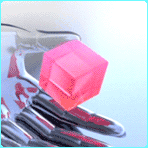|
I can't believe I forgot about the rapatronic camera!
|
|
|
|

|
| # ? May 25, 2024 00:21 |
|
Platystemon posted:That’s pretty clever. This one's for welding. https://www.youtube.com/watch?v=ygcm0AQXX9k
|
|
|
|
Phanatic posted:This one's for welding. Here’s the paper on the hardware. No spinning polarisers were used. Each camera just alternates between between short and long exposure times electronically. I’m kind of surprised that on‐sensor electronic shutter can handle that, but since it can, I suppose there may never be a need for the spinning polarisers.  All I can say for it is that it would allow invariant exposure times for +EV and ‒EV frames, but that would rarely be a problem in video, when even the slow frames must be strictly less than 1⁄framerate seconds. We’ve come a long way since the days of inadvertently frying the first colour video camera on the Moon by momentarily pointing it in the wrong direction. Platystemon has a new favorite as of 10:32 on May 7, 2016 |
|
|
|
Collateral Damage posted:Remember the fire triangle. Fuel-oxidiser-heat. If nothing else you might be able to make the fire run out of fuel more quickly.
|
|
|
|
LOx is probably a good subject for this thread if anyone knows more. It was ages ago and in highschool so I very likely misinterpreted or misremembered what was happening, but I was helping out over the summer with a lab building and commissioning a building scale LOx experiment. Everything needed an extremely rigorous solvent clean and dry because the smallest amount of organic contaminant could combust at the small pressure and velocities present in the system, which could cause an overpressure at best and maybe ignite the stainless steel at worst.
|
|
|
|
chrisoya posted:I want to believe that if all you have is a tank of very cold liquid oxygen and a hose, you can put out a fire. On a long enough time scale, every fire gets put out. If you think about it that way, hosing a fire with LOx will put a fire out. The fire will also quickly use up some additional fuel sources such as, the hose, the tank, you, and all other combustible material it can find in a quickly expanding radius.
|
|
|
|
I'm pretty sure you could use lox to put out a fire. It'd be the same way they use dynamite to put out oil well fires - a big explosion that pushes all the hot stuff away from the fuel source.
|
|
|
|
You could probably find one where it would work but it seems like there's a lot of hurdles. You'll have mass transfer issues actually getting oxygen density to the flammable media because liquid oxygen heat of vaporization is pretty abysmal. You also need to have flammable media that just conflagrates at atmospheric O2 but would detonate with excess O2. After detonating you might still be screwed, because now you have hot excess oxygen all around. The beautiful simplicity of bombing an oil well fire is you carry the exact stoichiometry to detonate and remove the oxidizer long enough, without bringing anything extra that would just antagonize the situation like trying to cause the media to detonate itself with excess oxygen.
|
|
|
|
What about dumping LOX on something burning with fluorine that wouldn't burn with oxygen? Cool it down and let the vaporization disperse the source of fluorine. This could end in disaster if, for example, you have a small puddle of ClF3 on whatever you're burning and this splatters the ClF3 everywhere, but the original fire would be extinguished.
GWBBQ has a new favorite as of 15:41 on May 7, 2016 |
|
|
|
I'm eagerly awaiting your lab report.
|
|
|
|
GWBBQ posted:What about dumping LOX on something burning with fluorine that wouldn't burn with oxygen? Cool it down and let the vaporization disperse the source of fluorine. This could end in disaster if, for example, you have a small puddle of ClF3 on whatever you're burning and this splatters the ClF3 everywhere, but the original fire would be extinguished. You might have a future in rocketry.
|
|
|
|
Collateral Damage posted:I'm eagerly awaiting your lab report. Report: lab missing.
|
|
|
|
Jabor posted:I'm pretty sure you could use lox to put out a fire. It'd be the same way they use dynamite to put out oil well fires - a big explosion that pushes all the hot stuff away from the fuel source. I think I posted this one before. https://www.youtube.com/watch?v=2eGES-MrIFo&t=125s
|
|
|
|
Cakefool posted:lab: missing.
|
|
|
|
I wonder if you can use lox as a rocket fuel. No, the other lox. Would probably require a bit of the other other lox as an oxidiser though.
|
|
|
|
Vitamins posted:I wonder if you can use lox as a rocket fuel. No, the other lox. Would probably require a bit of the other other lox as an oxidiser though. Refine it down to salmon oil and you might be on to something, it's plenty flamable. 
|
|
|
|
Vitamins posted:I wonder if you can use lox as a rocket fuel. No, the other lox. Would probably require a bit of the other other lox as an oxidiser though. Yes. Almost anything can be used as a rocket fuel, especially with the right oxidizer. The trick isn't finding things that will burn when exposed to LOx, ClF3, or FOOF. It's finding things that do it well without side effects like exploding or poisoning the entire state. https://www.youtube.com/watch?v=i0zon3xOaI4 TheDon01 posted:Refine it down to salmon oil and you might be on to something, it's plenty flamable. Ignition! said they tried some citrus oil as a fuel at some point. Quite possible they also tried salmon oil around that time, and it wound up being as stupid as expected. While not smelling bad enough to be worth mentioning in the book.
|
|
|
|
Cakefool posted:Report: lab missing.
|
|
|
|
Our science faculty are awesome and will let me do bits of fun stuff in the lab but I'm pretty sure there's a line somewhere and letting the guys from technology services play with fluorine compounds is pretty far across it. Since I know you're wondering, fun things include -A friend suspected a halon gas leak at work and asked if anyone knew what that particular one smelled like. I looked up the chemical name, headed down to the chem lab and asked what it would smell like. The professor said it would smell like bromine and difluoroethane, and ran to the storage closet to grab bottles for me to smell. Armed with this knowledge, we determined that it wasn't a halon leak. -I ordered some plenum rated cable and suspected it was counterfeit. Like any reasonable person would do, I cut off a few inches of it and asked the same professor "can I set something on fire in a fume hood?" His response was "sure, as long as it's not too big. What are we burning?" I have the charred piece of "plenum rated" cable in a glass vial on a shelf in my office and I got my money back for the cable. -Hanging out in the biology lab and jokingly asking "can I mix chemicals together and see what happens?" "Sure, go ahead." I rummaged through the cabinets and grabbed myself a beaker and a bottle of potassium permanganate, but sadly they had just run out of glycerine.
|
|
|
|
GWBBQ posted:What about dumping LOX on something burning with fluorine that wouldn't burn with oxygen? Cool it down and let the vaporization disperse the source of fluorine. This could end in disaster if, for example, you have a small puddle of ClF3 on whatever you're burning and this splatters the ClF3 everywhere, but the original fire would be extinguished. In the thread's bible, the book Ignition!, rocket technicians' reflexive response to the unexpected appearance of a puddle of chlorine trifluoride on a hangar floor was to scream and curse and run away as far and fast as possible. Everybody got out of the hangar alive but one rapidly accelerating worker only made it a few hundred feet before dropping dead of a stress-induced heart attack. Emergency protocol was for everybody to evacuate the area or hide in bomb shelters and wait until the ClF3 finished burning through several feet of concrete and gravel, leaving a big smoking crater. And that was close to a best case scenario for a ClF3 spill.
|
|
|
|
Syd Midnight posted:In the thread's bible, the book Ignition!, rocket technicians' reflexive response to the unexpected appearance of a puddle of chlorine trifluoride on a hangar floor was to scream and curse and run away as far and fast as possible. Everybody got out of the hangar alive but one rapidly accelerating worker only made it a few hundred feet before dropping dead of a stress-induced heart attack. Emergency protocol was for everybody to evacuate the area or hide in bomb shelters and wait until the ClF3 finished burning through several feet of concrete and gravel, leaving a big smoking crater. Isn't that the stuff from Sand Won't Save You? He mentions a one-ton spill of the stuff.
|
|
|
|
He did mention it, but it was sourced from Ignition! Also I don't know if that technician actually died (John Clark said "nobody was killed, but there was one casualty"") considering he reported the guy reaching "Mach 2 and still picking up speed"; the velocity was obviously hyperbole, I think there's a good chance the "heart attack" was, too. E: the quote in question Ignition! posted:It happened at their Shreveport, Louisiana, installation, while they were preparing to ship out, for the first time, a one-ton steel cylinder of CTF. The cylinder had been cooled with dry ice to make it easier to load the material into it, and the cold had apparently embrittled the steel. For as they were maneuvering the cylinder onto a dolly, it split and dumped one ton of chlorine trifluoride onto the floor. It chewed its way through twelve inches of concrete and dug a three foot hole in the gravel underneath, filled the place with fumes which corroded everything in sight and, in general, made one hell of a mess...Miraculously, nobody was killed, but there was one casualty—the man who had been steadying the cylinder when it split. He was found some five hundred feet away, where he had reached Mach 2 and was still picking up speed when he was stopped by a heart attack.
|
|
|
|
^^^ Yeah that sounds like he was just doing the right thing and running away from a horrific death.GWBBQ posted:-Hanging out in the biology lab and jokingly asking "can I mix chemicals together and see what happens?" "Sure, go ahead." I rummaged through the cabinets and grabbed myself a beaker and a bottle of potassium permanganate, but sadly they had just run out of glycerine. TheDon01 has a new favorite as of 04:26 on May 8, 2016 |
|
|
|
TheDon01 posted:Without looking it up I'm guessing this makes a few cubic meters of foam or something right? Nah, fire. After a few seconds it ignites, and it burns itself out fairly quickly.
|
|
|
|
TheDon01 posted:^^^ Yeah that sounds like he was just doing the right thing and running away from a horrific death. Potassium permanganate is one of the stronger oxidizers that non-rocket scientists whose names don't sound like an explosion use.
|
|
|
|
I mix it with glycerin to light thermite.
|
|
|
|
Carbon dioxide posted:Potassium permanganate is one of the stronger oxidizers that non-rocket scientists whose names don't sound like an explosion use. It's also a beautiful purple colour in solution. (This is how a breathalyzer works).
|
|
|
|
The Lone Badger posted:It's also a beautiful purple colour in solution. (This is how a breathalyzer works). And it creates lovely stains but a little bit of dilute hydrogen peroxide in acidic solution will remove those easily.
|
|
|
|
jetz0r posted:Ignition! said they tried some citrus oil as a fuel at some point. Quite possible they also tried salmon oil around that time, and it wound up being as stupid as expected. While not smelling bad enough to be worth mentioning in the book. They tried thiols and mercaptans, I don't think they would have though the smell of fish oil to even be worth mentioning. Ignition! posted:And finally he surpassed himself with something that had a dimethylamino group attached to a mercaptan sulfur, and whose odor can't, with all the resources of the English language, even be described. It also drew flies.
|
|
|
|
Zopotantor posted:And it creates lovely stains but a little bit of dilute hydrogen peroxide in acidic solution will remove those easily. Good way to quantify peroxide in solution. Stains your skin too!
|
|
|
|
DemeaninDemon posted:Stains your skin too! IIRC it was used for artificial tans. 
|
|
|
|
Kazinsal posted:Nah, fire. After a few seconds it ignites, and it burns itself out fairly quickly. When I demonstrated it for my chemistry classes, I introduced it as "The Arsonist's Friend." There's an induction period as the glycerin begins to react and generate heat. That speeds up the reaction of the rest of the glycerin, so the heat generated increases rapidly and after 30 seconds or so finally bursts into flame. Meaning, an arsonist would have time to get out of the house before it all went up. Of course, the permanganate residue would be pretty obvious to an investigator, but that's beside the point of its delayed ignition.
|
|
|
|
Deteriorata posted:When I demonstrated it for my chemistry classes, I introduced it as "The Arsonist's Friend." There's an induction period as the glycerin begins to react and generate heat. That speeds up the reaction of the rest of the glycerin, so the heat generated increases rapidly and after 30 seconds or so finally bursts into flame. Well yeah, most arsonists don't give a drat if someone finds out it's arson. It's the people who go around trying to commit insurance fraud who would care about that. Delayed ignition reactions are pretty cool though. Also a good way to lose eyebrows if you don't know what you're doing.
|
|
|
|
Found an erlenmeyer flask at Value Village, actual pyrex, glass stopper, all that jazz. had HH penciled in on it. Any ideas what that could be? Also, how do I clean it, just the standard diluted muriatic acid or an autoclave?
|
|
|
|
Kilo147 posted:Found an erlenmeyer flask at Value Village, actual pyrex, glass stopper, all that jazz. had HH penciled in on it. Any ideas what that could be? Also, how do I clean it, just the standard diluted muriatic acid or an autoclave? or just run it through a dishwasher. How thoroughly you need to clean it and how depends on what you intend to use it for. The HH probably stands for Hubert Humphrey, who was dissolved in a vat of acid after he died.
|
|
|
|
Deteriorata posted:or just run it through a dishwasher. How thoroughly you need to clean it and how depends on what you intend to use it for. well, its graduated, so using it for baking seems like a good start, but there's that idea that it had some crazy poo poo in it that keeps me from doing that. It's old pyrex, has some loving heft behind it.hence why i want to reuse it.
|
|
|
|
Kilo147 posted:well, its graduated, so using it for baking seems like a good start, but there's that idea that it had some crazy poo poo in it that keeps me from doing that. The graduations on an erlenmeyer are not very accurate, so I wouldn't recommend them as volumetric ware. The markings are to give you a rough idea of how much is in it. You measure out a volume of a liquid with a pipette, a graduated cylinder, or a volumetric flask. The erlenmeyer is what you then dump it into. I guess it may be close enough for baking, but a set of measuring cups would probably be better.
|
|
|
|
Deteriorata posted:The graduations on an erlenmeyer are not very accurate, so I wouldn't recommend them as volumetric ware. The markings are to give you a rough idea of how much is in it. Huh, had no idea they weren't that accurate. Oh well. Irregardless, a trip in the dishwasher should be enough to clean it out to foodsafe standards?
|
|
|
|
Dishwasher is probably fine but who knows without the full history. If you're paranoid you should do a caustic scrub, rinse, acid scrub, rinse, dish washer. If you're worried about organic residue you can start with a polar solvent like vodka, rubbing alcohol, or even acetone for maximum polar solvation, rinse with water several times and blow dry, then the caustic scrub, rinse, acid scrub, rinse, dish washer. e. and if you really want to get into language use, the gradations are generally accurate but are of super poo poo precision. Which at the end of the day means it is still poo poo as a measurement vessel for baking. zedprime has a new favorite as of 23:22 on May 8, 2016 |
|
|
|

|
| # ? May 25, 2024 00:21 |
|
Accuracy on a flask like that's about +/- 5-10%. I wouldn't recommend measuring things for baking in it. Unless you use mass.
|
|
|













































